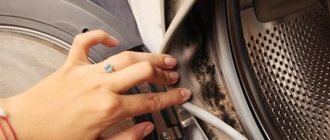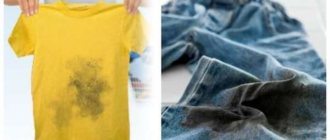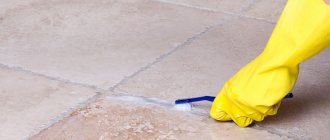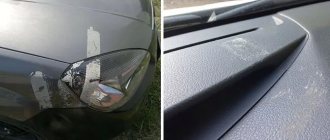Summer tires of foreign and domestic production.
. Car tire store with prices. The warm season is the time for road repairs. Every year, road workers dig up the road, fill up holes, lay down new asphalt, but the roads don’t get any better. After all, a bypass road is not provided for the sake of economy, and overloaded trucks immediately drive along the still damp, newly laid asphalt, mercilessly crushing the new road under them. And then we, the cars, drive along and catch stones covered with bitumen from under the wheels of the trucks.
For high-quality cleaning of bitumen stains, we recommend contacting a detailing center.
Drivers of many heavy-duty vehicles don’t even bother to install mud flaps. In addition, a passenger car driving on freshly laid asphalt is capable of dirtying itself. Stones, sticking to the wheels, fly into the body and leave bitumen stains on the paint. In this article we will tell you how to clean bitumen, how it acts on paint and what types of bitumen stain cleaners are available.
What are bitumen stains on a car and why are they dangerous?
Bitumen stains are traces of bitumen that gets onto the body from the wheels from the road surface and sticks to it. If stains are not removed in time, serious problems can arise. Namely, the varnish that covers the paint may be damaged. This is real and absolutely accurate. Bitumen enters into a chemical reaction with the varnish and over time the varnish becomes dull and yellow.
The fact is that the basis of a car's paintwork is solvents. The resin, which is part of the bitumen, is also diluted with solvents. When bitumen gets on the paintwork, it easily eats into the varnish and then into the paint itself. The solvent embedded in the paint evaporates, and the resin remains deep in the paint. In this case, bitumen stains on the car cannot be washed off with anything. To prevent such a disaster from happening, stains must be washed off as quickly as possible. The clock is counting. Especially in hot weather, when the car body heats up to 50-70 degrees. Liquid bitumen or tar also contains a lot of oil fractions and penetrates the paintwork many times faster.
We will tell you how to properly wash bitumen from your car without damaging the paintwork.
Professional compositions
They differ from universal ones in their improved composition. Professional products contain petroleum fractions that remove bitumen and tar contamination, as well as other special additives. The disadvantage is excessive aggressiveness. They require careful adherence to instructions and work experience. If you plan to use such a product, it is better to first test the product on a small area. Among the most popular professional formulations that are recommended for use at home are the following:
- Mazbit Turbo made in USA;
- "Profam-3500", produced in Russia;
- Cleaner with fresh citrus scent No. 7535, produced in Sweden;
- Teer Entferner, which is produced in Germany;
- TurtleWaks, proven in the fight against bitumen stains.
Among the latest developments, you should pay attention to synthetic clay, which is similar to plasticine, removes not only bitumen, but also other contaminants, and is also very delicate, without damaging paint and varnish. You can also use a special auto scrub, which is made of rubberized material in the form of a napkin, circle or mitten.
How to wash bitumen from a car?
As you already know, bitumen penetrates the car’s paint very easily and quickly, so if you are on a long journey and have stained your car with bitumen, the only right decision is to go to the first car wash. If it is possible to do this at home, do not delay it, do not wait until the next day.
Once on the body, bitumen hardens gradually, and it becomes more and more difficult to wash it, so this must be done while it is fresh.
Today, there are a lot of chemical products on the market for removing various stains from a car body, both expensive and cheap. Bitumen stain cleaners are divided into two groups: special and universal. Almost all of them are imported; they contain alcohols, alkalis, as well as water-soluble additives and surfactants. These cleaners cope well with biological contaminants - stains from tree buds, remove traces of insects, bird droppings. However, not all preparations cope with oil pollution and bitumen or do not cope well enough. But it is worth noting that if bitumen stains from the car’s paintwork are not cleaned in time, then no product will help, even the most branded and expensive one.
A strong recommendation! Carry a bitumen stain remover in your car, not necessarily an expensive one, and at least one bottle of water. An alternative to the cleaner can be regular margarine, we’ll talk about it a little later. This set will not clutter your trunk, but it will be very useful. Since road bitumen quickly eats into the paint, it must be removed immediately, no later than 24 hours. Over the course of a few days, the resin and solvent penetrate deeper into enamel of any complexity and thickness. As soon as you have passed the section of road being repaired, stop in a safe place and wash off the top layer of dirt in areas where there is bitumen. This is necessary in order to avoid rubbing dirt and dust on the body, as this can scratch the paintwork.
Then clean the bitumen with an appropriate product. The bitumen just got on the paint and has not yet had time to be absorbed, so you can easily clean it even with an inexpensive product. Once the tar stains have been removed, rinse the areas again with water. We will now tell you how to properly clean bitumen stains with the product. This whole procedure will take about 15 minutes. If you put it off until tomorrow, the consequences will be sad, and you will spend much more time and money to save the paint.
Prevention
As you know, the best repair is prevention. There are a few simple rules that will help you reduce the risk of unpleasant and difficult to remove stains from the body of the “iron horse”.
A few simple rules can help protect your car from bitumen. The fact that bitumen on the road melts is visible to the naked eye in the summer heat, so try the following:
- If you are moving along an area with freshly laid asphalt, reduce your speed to 40-50 kilometers per hour.
- Make as little steering movement as possible.
- Stay as far away from the vehicle in front as possible.
- Do not approach specialized vehicles that transport bitumen.
- Do not drive on a compacted track, as the asphalt melts faster on it.
It is better to avoid such areas of roads with fresh bitumen as far as possible.
How to wash bitumen from a car?
Before you start cleaning the bitumen from the body, you need to wash the car so as not to scratch the varnish (how to wash the car yourself and not harm the body?). Road bitumen contains small abrasives: asphalt particles, sand. Therefore, you should not wash off bitumen stains with a rag or sponge. It would be better to take the extra time and carefully remove bitumen stains with a brush or rag.
If the bitumen has already been absorbed into the varnish, you will have to clean it gradually. You cannot apply bitumen stain cleaner and immediately rub it with a rag, otherwise you will ruin the paintwork. You need to remove stubborn bitumen stains on your car in the following order:
- Apply the product to the area contaminated with bitumen and let the product absorb a little, leaving for 2-3 minutes.
- Use a soft brush to remove bitumen from the surface. It is advisable to water the area with water when working with a brush. If you don't have a brush, you can use a microfiber cloth. You need to work with microfiber very carefully, do not rub or press on the surface of the body, but simply wash off the dirt from top to bottom.
- Repeat the procedure.
- After all the stains have been removed, the car must be washed again and then polished. Instead of polishing, you can use protective wax. It is applied during the washing process.
After removing bitumen stains, protective polishing of the body is mandatory! All drugs in one way or another harm the paintwork, leaving it vulnerable (how to properly polish a car and coat it with protective wax?).
Why is a professional bitumen cleaner dangerous?
Many drug formulations are very active and have a negative effect on the car’s coating. By washing the bitumen, you can also remove “liquid plastic”, anti-gravel, as well as anti-corrosion coating. If such protective coatings are present on the car, professional anti-bitumen preparations cannot be used. This is another confirmation that bitumen must be removed from the body as quickly as possible.
So-called special bitumen stain cleaners are safer. But they are effective only for fresh resin, since environmentalists strive for a minimum content of active volatile solvents in preparations.
How to wash bitumen from a car using improvised means?
Car owners who like to save on everything use a number of improvised means that also wash bitumen well, but only fresh ones. These are kerosene, gasoline, diesel fuel, various solvents, acetone, white spirit. Experts categorically do not recommend using such products. They have an unpleasant odor, and most importantly, they definitely harm the paintwork.
Perhaps the safest available means for cleaning bitumen from a car body is, oddly enough, ordinary margarine. It contains fatty acids. These acids dissolve still fresh resin or tar.
Important nuances for removing bitumen stains
To get rid of resin and not damage the car’s paintwork, you must follow certain rules:
- always read and adhere to the instructions supplied with the product;
- wash and clean the body before removing bitumen;
- allow the surface to dry thoroughly before cleaning the paintwork from resinous stains;
- apply the product from above so that it flows down evenly;
- let the composition “stand” for the time specified in the instructions;
- volatile agents, which include all solvents, should be applied in small doses;
- It is better to remove stubborn stains with a brush or brush, working the area point by point;
- Be sure to wash the car with car shampoo and clean water, since all bitumen removers leave a greasy residue.
Bitumen should always be removed fresh. This will avoid the problem of removing old resin.
What to do if bitumen can no longer be washed off with anything?
So, you already know that you cannot leave bitumen on the body for a long time. The resin and solvent will be absorbed very deeply into the paint in just a couple of days. Then the solvent gradually evaporates, and the resin remains in the very depths of the paint. In this case, no chemical agent will help remove bitumen stains. The only solution to the problem is deep polishing. That's why we want to convince car owners not to be lazy, but to wash bitumen stains from the body as quickly as possible. This must be done on the spot, so you will not harm the paintwork. You can wash the bitumen after a few hours, but then you will have to use professional bitumen stain cleaners that contain solvents. And, as you know, solvents have a detrimental effect on varnish.
There is another way. But this method does not involve removing bitumen stains, but masking them. That is, deep stains that cannot be washed off are simply covered with so-called “colored polish.” After using this polish, no traces of bitumen are really visible, but this effect does not last long. After a few washes, the polish will wash off, and the ominous black spots will again spoil the appearance of the car.
In conclusion, I would like to remind you of an important rule: after each use of bitumen cleaners, the car must be washed and polished with a protective polish or wax. Then the paintwork of your car will remain in the same condition. By the way, polish and wax your car more often. It repels moisture and various chemical impurities from the road, and most importantly, it delays the penetration of bitumen into the paint. You will learn how to do this correctly on our website, just follow this link.
Cleaning synthetic materials
When we start cleaning clothes from bitumen from synthetic materials, there is a high risk of them being damaged or even disappearing from contact with solvents. These products, together with bitumen, also destroy fabric. Perhaps such actions will have to be abandoned.
You can start by removing bitumen particles by hand. Next, try using purified kerosene or BR-2 gasoline solvent, which can be purchased at automotive stores. They do not have such an aggressive effect on the fabric. On artificial fibers, it is advisable to test all solvents before using them on inconspicuous areas of the item to find out the degree of their impact. Solvent 647 or 646 is considered not a very strong agent.
After destroying the stain, you should immediately wash it, adhering to the temperature regime. To improve the quality of washing, you can add stain remover powder or Vanish.
Among the effective methods, some are also used for natural fabrics. For example, manipulations with butter.
Wash carefully following the manufacturer's recommendations on the clothing label.
Remedy No. 4. Kerosene
One of the best folk remedies for removing both fresh and hardened bitumen stains. Kerosene is sold packaged in bottles in hardware stores (you can find it on shelves with various solvents). It is good because it works the first time it is used. The main thing when working with kerosene is to give it enough time so that it has time to dissolve the resin.
Kerosene is even more dangerous than gasoline in terms of fire! This should be kept in mind while working.
Remedy No. 1. WD-40
Everyone’s favorite “Vedashka” is considered first because it is found in almost every garage today. In addition to the fact that this composition is able to displace moisture and lubricate rubbing parts, it dissolves resin without any problems. But only relatively “fresh”. If bitumen stains have been on the body or wheels for a very long time, then WD-40 may not cope with them the first time.
To use this product, you will need a soft rag or cotton swabs. The contaminated area is washed from dirt and dust. Next, the resin stains are treated with a “wedeshka”, after which the resin is given time to dissolve. As a rule, if the bitumen is relatively “fresh”, then it is enough to wait 3-4 minutes. After this, stains can be removed with rags or wipes soaked in WD-40.
Here and further - if after the first treatment the stains are not erased with a slight movement, then in no case should you rub hard. It is better to reapply the product and give the resin more time to dissolve.
What available tools can you use?
If for some reason it is not possible to purchase a special composition, you can use improvised materials to remove stains. Conventionally, they can be divided into several groups:
- kerosene and kerosene-containing products;
- solvents.
Aviation kerosene has been considered the standard product for combating tar and bitumen stains at home for many years. Getting it, however, has not become any easier, so you have to make do with regular kerosene. And for company with him - diesel fuel, gasoline, WD-40, carburetor cleaning fluid and white spirit, of which approximately half of WD-40 consists.
The main disadvantages of these methods are that you act at your own peril and risk, and you end up with a not-so-pleasant smell. White spirit can deprive the area being cleaned of its shine, WD-40 is only suitable for fresh stains, and kerosene can “grab” part of the paint along with the stain if you overdo it. However, kerosene and diesel fuel are still safer in this regard than gasoline.
While some claim that these home remedies can remove stubborn stains with some effort, it's best not to take any chances. It didn’t work out with one, or maximum two, attempts, switch to special means or contact specialists. The action time of kerosene, gasoline and diesel fuel is 2–5 minutes.
It should also be remembered that these substances leave greasy stains on the surface.
Let's talk about working with white spirit in more detail.
- Use a mask and gloves when working.
- Wash the car thoroughly with special shampoo.
- Wait for the car to dry.
- Dip a foam sponge or cotton pad into the solvent.
- After waiting 5 minutes (some people think 3-4 minutes is enough), begin to wash the stain.
- If you see that there is no effect, do not try to put more effort. Switch to a special product. Although there is an opinion that you can safely repeat these manipulations up to 5 times.
And some recommendations for using other means.
- It is enough to leave WD-40 on a fresh stain for 3-4 minutes.
- If you don’t have car shampoo on hand, dishwashing detergent will do an excellent job of removing the smell of diesel fuel and the greasy residue left behind.
- Gasoline, diesel fuel and kerosene are extremely flammable. This seemingly simple truth is often forgotten. And such forgetfulness comes at a cost.
Pharmacy drugs
You can also find the cleaner in your first aid kit. Such folk remedies include formic alcohol, 3% boric acid and ammonia. Again, proceed with caution. And they work slower - the stain will take at least 5-10 minutes to dissolve, and most likely longer. For example, ammonia is used as follows:
- moisten a cotton swab with the product;
- place the swab on the stain;
- wait 5 minutes;
- remove the swab and wash the car.










